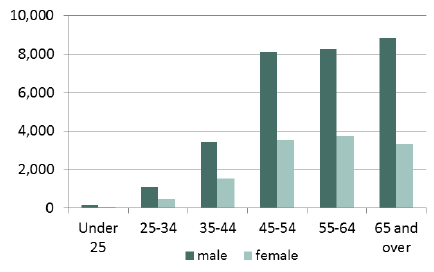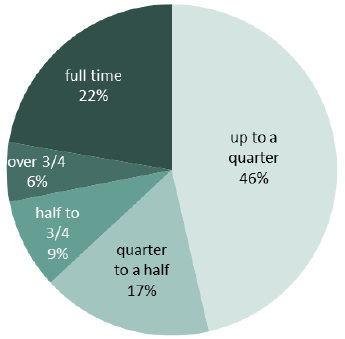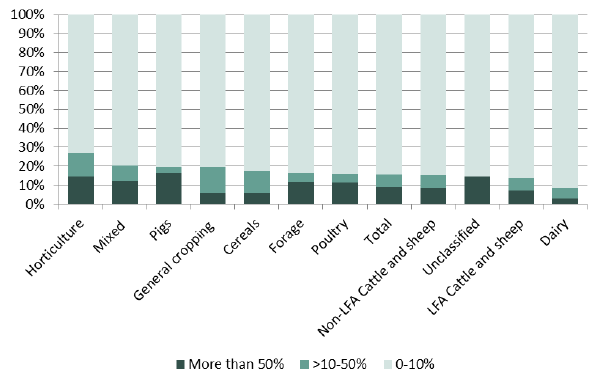Scottish Survey of Farm Structure and Methods, 2016
Scottish statistics from the EU Farm Structure Survey 2016.
3. Farm Structure
3.1 Labour
Chart 1: Age profile of occupiers and managers

Source: Table 3
The day-to-day running of the holding was the responsibility of the occupier or member of their family for 89 per cent of holdings, with the remaining run by a manager. Note that, in this publication, 'occupier' relates to any individual (i.e. not an estate, church or limited liability company with legal and financial responsibility).
Those holdings where the legal and financial responsibility lay with an institution (e.g. limited company, church, estate) accounted for 4.7 per cent of holdings.
Sixty-seven per cent of occupiers were male (if managers are included the proportion is 70 per cent).
The age profile of occupiers shows increasingly large proportions as the age-group increases, as one might expect in family-run businesses, but with 31 per cent of occupiers aged 65 or older (29 per cent if managers are included). Only three per cent of occupiers were under 35.
Chart 2: Work-profile of person responsible for running the farm

Source: Table 4
Twenty-two per cent of those running the farm reported they worked full-time on the holding, with over sixty per cent reporting they worked less than half time.
Chart 3 shows a comparison by size (in terms Standard Labour Requirements ( SLRs [1] )) for two categories of owner. Holdings where managerial responsibility is undertaken by the representative of an institution, such as a limited liability company, church or estate, had a slight tendency to be larger, with almost one quarter (23.7 per cent) of those holdings having an SLR value of two or more compared with just over a fifth (20.5 per cent) of holdings managed by the occupier, a family member or a business partner.
Chart 3: Person running farm by farm size
Percentage distribution

Source: Table 2b
Over a third (37.5 per cent) of family members working on the farm reported that at least some of their time was unpaid labour.
3.2 Training
Chart 4: Qualification of those running farms

Source: Table 5
The survey also asked about the level of qualifications of the manager (or occupier with managerial responsibility). Eighteen per cent had completed a full agricultural training course of two years or more, ten per cent had completed a basic course of less than two years, with the remaining 72 per cent having practical agricultural experience only. In 2013, 17 per cent had completed full training, with 73 per cent having practical experience only.
Just over one per cent of those managing farms said that they had undergone some vocational training in the last 12 months.
3.3 Diversification and Income ( Tables 6- 8)
Of the various "other gainful activities" taking place on the holding that were asked about, the most common was tourism, which was reported on ten per cent of holdings. Contract work (agricultural work) and 'other' activities were reported on six per cent of holdings, while renewable energy for sale to the market was reported on four per cent of holdings. Overall, 25 per cent of holdings reported other gainful activities on the holding, compared to 21 per cent in 2013.
Chart 5: Proportion of holdings reporting other gainful activities

Source: Table 6
In terms of income from these activities, 16 per cent reported that it accounted for more than ten per cent of their turnover, with just over half of these (nine per cent) reporting more than half of their turnover coming from other gainful activities.
Looking at the proportion of income from other gainful activities by farm type [2] , horticulture holdings and mixed holdings were most likely to acquire more than ten per cent of their income from other gainful activities (27 per cent of horticulture holdings and 20 per cent of mixed holdings). In contrast, only eight per cent of dairy holdings obtained more than 10 per cent of their income from other gainful activities.
Chart 6: Proportion of income from other gainful activities, by farm type

Source: Table 7
Five per cent of holdings reported they sold more than half of their produce direct to individuals (rather than wholesalers, shops or restaurants).
Contact
There is a problem
Thanks for your feedback